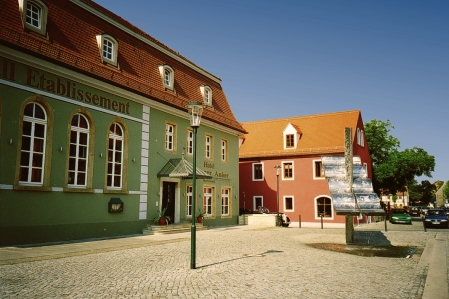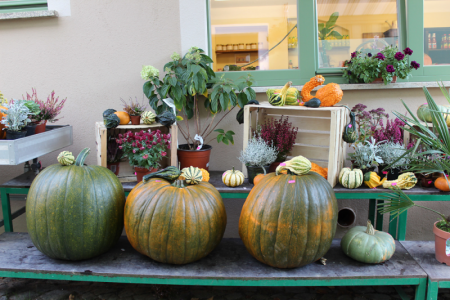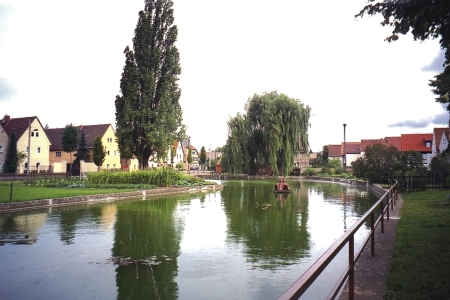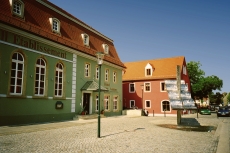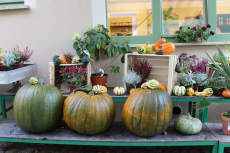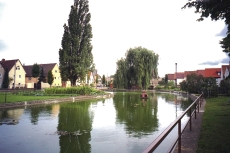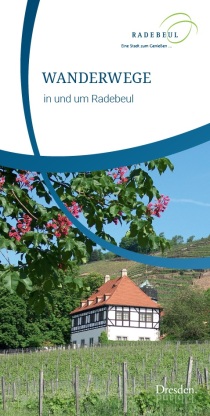From Altkötzschenbroda to Naundorf
The hike begins at the tram stop on tram line 4 "Moritzburger Straße" or the S-Bahn stop on the S1 "Radebeul-Kötzschenbroda". Walk south along Bahnhofstraße and at the end of the street you will reach the village green of Altkötzschenbroda.
Your gaze falls directly on the "Goldener Anker" hotel, which was first mentioned in a document in 1497 as a "hereditary tavern with brewing rights". The building was the victim of several village fires. In its chequered history, it has served as a pub, concert and ballet venue, meeting place for local councillors and, in the 1970s, as a HO furniture sales outlet. After extensive renovation work, the hotel complex with its integrated ballroom has been shining in new splendour since 1999. The steel fountain sculpture "Gegen den Strom" was erected in the same year by Karl Menzen (Berlin).
Stroll along the village green and discover the many lovingly renovated three-sided courtyards. The layout of the village square corresponds to that of a Franconian street village, characterised by narrow, deep courtyards with gabled buildings. Most of the preserved half-timbered farmhouses and farmhouses with a solid basement date back to the 19th century. The most striking buildings on the village green include the Friedenskirche church, the vicarage, the Oberschänke tavern and the "Goldener Anker" hotel. In the 1970s, the entire village centre was to make way for a prefabricated housing estate. Students at the TU Dresden developed the first alternative designs. In 1994, Altkötzschenbroda was declared a redevelopment area. From 2000, the village green was transformed into an architectural gem. Original pubs, cafés, guesthouses and hotels opened around the village green. Today, Altkötzschenbroda is one of the most popular excursion destinations for visitors from near and far. At the eastern end of the village green, you will discover the Friedenskirche church - the oldest church building in Lößnitz. First mentioned in a document in 1273 and later destroyed by the Hussites, a new late Gothic building was erected from 1477. It was almost completely destroyed again in 1637 during the Thirty Years' War. It was rebuilt in the Renaissance style and completed in 1656. The name Friedenskirche (Peace Church) goes back to the armistice treaty signed between Saxony and Sweden in the nearby vicarage in 1645, which is commemorated by a small memorial room on the tower floor of the church. Between 2003 and 2005, the church was partially renovated and received new bronze bells, as the old ones were melted down during the Second World War and replaced with iron bells.
On the way back towards the "Goldener Anker" hotel, you should take a look at the Altkötzschenbroda 21 courtyard, where the Stadtgalerie is located. The two-storey gallery space and the romantic courtyard with the Heimatstube (local history parlour) offer a variety of opportunities for exhibitions of painting, graphics, sculpture and history.
At the end of the village green, at the level of the "Bürgergarten" restaurant, turn left into Uferstraße and follow it straight ahead. On your way you will come to the landing stage of the Saxon Steamship Company. The historic paddle steamers regularly dock here on their way between Dresden and Diesbar-Seußlitz. From the boats, you can enjoy a fascinating view of the picturesque vineyards along the Elbe.
The route continues along the Elbe cycle path, lined with countless allotments, until you reach the junction "Vierruthenweg". Follow this and then turn right onto Niederwarthaer Straße. Continue straight ahead, cross Kötitzer Straße and you will reach the village green of Altnaundorf. The square village with its regular, typically Franconian village green layout originally comprised around 30 farmsteads. In the centre is the village pond, which was created after a devastating village fire in 1822. In the last quarter of the 19th century, the population of Altnaundorf began to grow rapidly, so that a new school building was started in 1878. In the courtyards you will often find small wine cellars, which can be hired for private parties.
At the end of the village green, turn right onto Johannisbergstraße, turn left at the end, cross the pedestrian tunnel and continue straight ahead to the tram stop for line 4 in the direction of Weinböhla or Dresden.
Details of the hike
| Distance: | ca. 5 km |
|---|---|
| Duration: | 2 - 2,5 Stunden |
| Height: | 0 m |
| Difficulty: | leicht |
In the brochure "Hiking trails in and around Radebeul" you will find these and many other hiking suggestions. Available from the tourist information centre.





